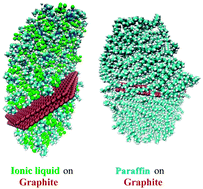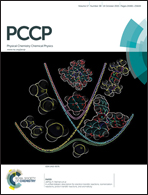Why is the electroanalytical performance of carbon paste electrodes involving an ionic liquid binder higher than paraffinic binders? A simulation investigation†
Abstract
Recently, carbon paste electrodes (CPE) fabricated using an ionic liquid (IL) binder have shown enhanced electroanalytical performance over conventional paraffinic binders. Molecular dynamics (MD) simulations of graphite mixed with ionic liquid and with paraffin binder can unravel the potential atomistic factors responsible for such enhancement. Based on an experimentally optimized binder/graphite mass ratio, which has been reported to be crucial for such a performance, comprehensive simulations (at 323 K) are performed with the ensembles involving an ionic liquid binder (1-butyl-3-methylimidazolium hexafluorophosphate, [C4mim]PF6) and a paraffin binder (n-C20H42) mixed with graphite comprising large-size hexagonal-shaped double graphene plates. Structural analysis indicates both binders form only a monolayer on the graphite surface, covering the surface locally by IL but all-encompassing by paraffin. With charged and uncharged graphite, the IL monolayer tends to cover mainly the graphite center without approaching the edge planes. On the contrary, a monolayer of the paraffin binder covers uniformly the center, near the center, and the edge planes. Cations and anions of the IL form well-defined two dimensional pentagonal matrixes with characteristic high adsorption energy, almost 2.4 times higher than paraffin adsorption. The cation and anion coordination ability of the IL is responsible for such a local distribution. The simulation of these phenomena under experimental conditions unravels strong two-dimensional coordination properties inherent to the ionic liquid when distributed over the graphite surface. This direct MD simulation comparison of the IL properties with an organic liquid counterpart, made for the first time, can be used to explain the high electroanalytical performance (electron transfer) of CPEs involving an IL binder over paraffin binders.


 Please wait while we load your content...
Please wait while we load your content...